Integrated marketing campaigns are 31% more effective at building brands.
However, as many as 70% of marketing teams still don’t have an integrated strategy.
So, with the knowledge that integrated marketing can help build brands, why aren’t more marketers using it?
One of the biggest roadblocks to using integrated marketing is internal alignment - ensuring all relevant stakeholders know what it is, how it helps, and agree on messaging.
To help you, in this article, we’ll explore integrated marketing, how it can positively impact your customers' experience with your brand, and how you can get started with it.
What is integrated marketing?
Integrated marketing is an approach to marketing across multiple channels that results in unified, repeated messaging and a consistent customer experience.
These marketing channels could include landing pages, advertising, websites, social media, and email, but the number of channels you can integrate is unlimited.
Marketing leaders are 1.5x more likely to integrate than mainstream marketers because it improves customer engagement and brand visibility while increasing ROI by up to 50%.
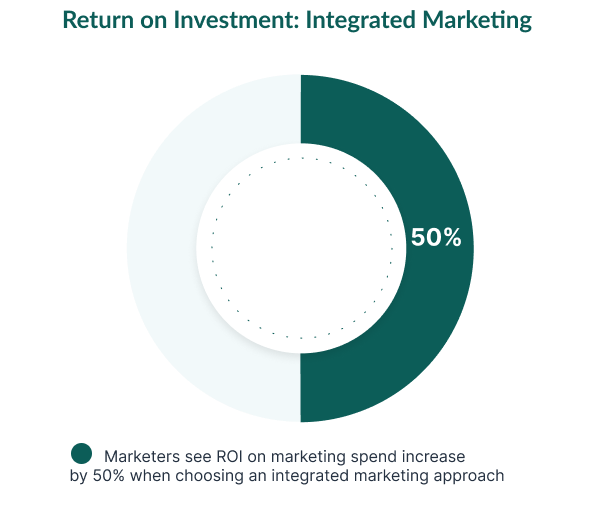
To keep your marketing truly integrated, the way you communicate with your customers needs to stick to the following principles;
- Stay consistent - make sure every channel uses the same look, feel, and tone.
- Connect everything - every channel you use should seamlessly link to the next.
- Think big - everything you do should be part of an overall brand experience.
Doing so, you’ll create a trustworthy, easy-to-follow, and compelling multi-channel marketing campaign that enhances your customers' experience.
How can integrated marketing impact customer experience?
Integrated marketing and customer experience are two distinct disciplines that have a lot in common.
Ultimately, they want to shape customer perceptions and expectations to leave a lasting impression and ensure long-term business relationships.
But how exactly can adopting an integrated marketing approach directly impact the overall experience for your customers?
Consistent messaging to build trust
Ensuring that your core messaging is consistent across all marketing channels - like web, email, and social media - can help create a positive customer experience.
While only 46% of marketing campaigns have integrated and consistent messaging like this, It’s a critical step in enhancing campaign performance and customer experience.
Using consistent messaging in integrated marketing campaigns can boost revenue growth by 20% and help your company become the obvious choice for potential customers.
This is because the careful and repeated use of the same messages, tone, and design style will help to build trust and help the customer feel comfortable with your brand.
This is essential for the overall customer experience, with 74% of consumers saying that transparent and honest communication is key to creating a ‘trusted customer relationship’.
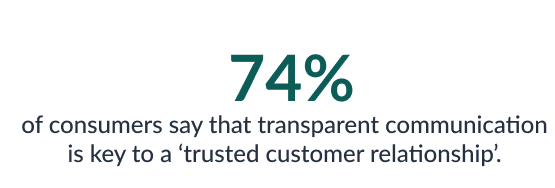
Personalized messages that customers find appealing
Even in B2B, every customer wants to feel that you recognize their specific problems and that your product can solve them.
Generic messaging may be OK for top-of-funnel content, but to really enhance the customer experience, you should combine integrated marketing with personalization.
Gathering data during your customers’ interactions with your integrated marketing channels allows you to personalize their messaging and overall experience.
Personalization in integrated marketing campaigns can increase sales by 20% and improve the customer experience, too, with 90% of consumers finding it ‘appealing’.
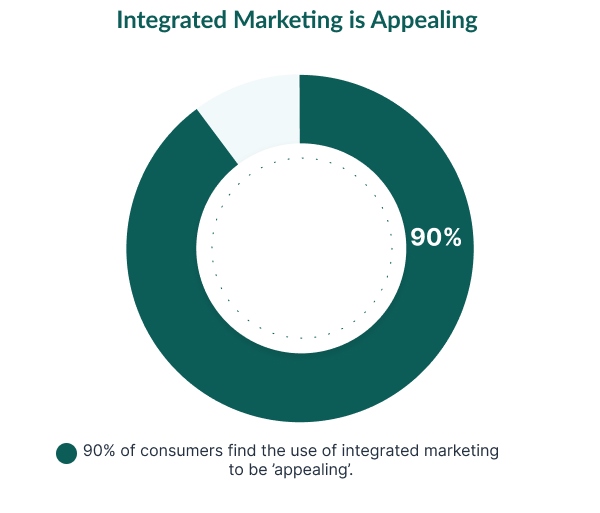
This is because personalization reassures your customers that your company is the right fit to solve their specific problems and leaves them highly satisfied with their choice.
Seamless multi-channel experiences reflect well on your brand
Going back to one of our core principles, when creating integrated multi-channel marketing campaigns, you should make every effort to connect each channel seamlessly.
For example, a prospect may see an ad on LinkedIn for your SaaS tool, click on the ad to visit a landing page, and sign up on the spot for a demo or free trial.
This process should be smooth and consistent with messaging and style to give customers confidence that they’ve made the right choice.
How effortless (or otherwise) the entire experience across marketing, sales, and service is for your customers directly impacts your ability to retain and grow customers.
Research backs this up: 60% of customers will likely churn if they receive a disconnected or inefficient experience across sales channels or customer touch points.

Increased levels of engagement and action
Creating a high-quality and consistent integrated marketing campaign across multiple channels can help increase customer engagement.
This engagement doesn’t just lead to more time spent consuming your content. Prospects will also take action (e.g., signing up for a demo or newsletter) or share it with others.
Because prospective customers find your multi-channel integrated marketing campaign compelling, their engagement and satisfaction can improve by up to 90%.
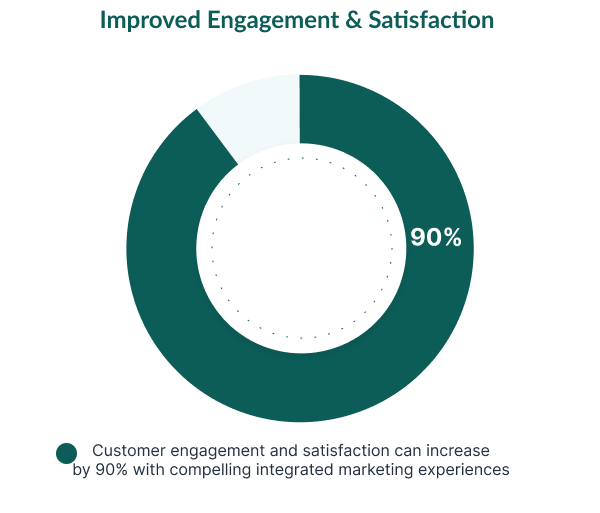
In addition, companies that take a strong approach to multi-channel integrated marketing are likely to retain, on average, 89% of their customers compared to those that don’t.
Set expectations and resolve support issues more easily
One of the biggest benefits of integrated marketing is that it can be applied to the entire customer journey - not just the initial lead generation marketing funnel.
This means that by offering consistent messaging across marketing, sales, and service, you can use this integrated approach to set customer expectations properly.
Customers who are clear on what they’re getting - and the limitations of your product - from the outset will be more satisfied overall and less likely to need support.
In addition, your integrated marketing approach can include content that will help you support customers more effectively, reducing the load on your service desk.
This is supported by research that found customer satisfaction is 23 times higher for companies that run a well-integrated omnichannel experience.

Your customers will be more loyal
Due to the consistent messaging in your integrated marketing, your customers will not only trust you more and be more satisfied but also more loyal.
Research has found that there can be a 48% variance in loyalty levels among customers who have experienced integrated marketing compared to those who haven’t.
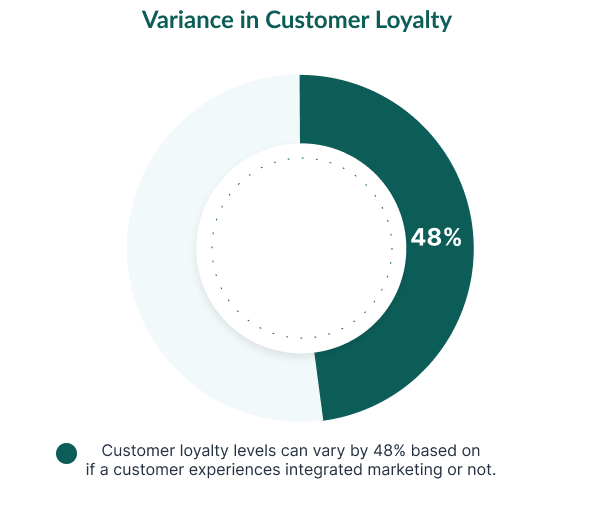
As we know, loyalty leads to increased customer retention. Your most loyal customers are up to 88% more likely to repeat purchases from you.
Improved brand perception leads to advocacy and referrals
One of the biggest advantages of a properly executed integrated marketing strategy is that customers are more likely to consider your brand professional and reliable.
Not only can this impact initial sales as customers choose to become customers, but it can also have additional benefits much later on in the customer journey.
Because customers are highly satisfied with brands that execute integrated marketing well, they’re more likely to become advocates and generate word-of-mouth referrals. This is important as a source of growth because referral customers have a 25% higher profit margin and are 18% more loyal than customers referred by other means.
Of course, creating consistent experiences across multiple marketing channels is only possible with the right tools.
So, consider a CRM to help you manage integrated marketing campaigns across the entire customer journey.
How can a CRM help you manage integrated marketing and improve customer experience?
Integrated marketing allows your company to improve brand awareness, increase customer engagement, and boost the return on investment of your marketing spend.
In addition, it helps create a cohesive and compelling experience for your customers, leading to increased customer loyalty and the chance to avoid unnecessary churn.
However, your marketing, sales, and service teams must align on using consistent messaging and approaches to do this successfully.
To guarantee that your marketing, sales, and service teams are all working together, you’ll need a central source of truth regarding customer data and communications.
A unified CRM platform like SuperOffice helps to bridge the gap between marketing, sales, and service to create a 360° view of the customer and their experience with your company.
SuperOffice offers several features to help you run integrated marketing campaigns and enhance your overall customer experience, including;
- Enhanced filtering and segmentation to target specific types of customers
- Advanced marketing and personalization options to tailor every message
- Consistent messaging across multiple touchpoints like chat, email, and portals
- Easy to use automation to deliver messages exactly when customers need them
- And much, much, more…
Ready to create incredible customer experiences by leveraging integrated marketing?
Book a demo of SuperOffice today and learn how a single CRM platform can help you integrate marketing with sales and service for an enhanced customer experience.



